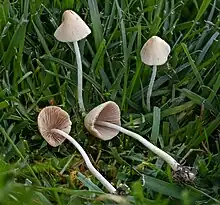Conocybe apala
Conocybe apala is a basidiomycete fungus and a member of the genus Conocybe. It is a fairly common fungus, both in North America and Europe, found growing among short green grass. Until recently, the species was also commonly called Conocybe lactea or Conocybe albipes and is colloquially known as the white dunce cap[1] or the milky conecap. [2] Another common synonym, Bolbitius albipes G.H. Otth 1871, places the fungus in the genus Bolbitius.
| Conocybe apala | |
|---|---|
 | |
| Scientific classification | |
| Domain: | Eukaryota |
| Kingdom: | Fungi |
| Division: | Basidiomycota |
| Class: | Agaricomycetes |
| Order: | Agaricales |
| Family: | Bolbitiaceae |
| Genus: | Conocybe |
| Species: | C. apala |
| Binomial name | |
| Conocybe apala ((Fr.) Arnolds, 2003) | |
| Synonyms | |
|
Conocybe lactea | |
| Conocybe apala | |
|---|---|
| Gills on hymenium | |
| Cap is conical | |
| Hymenium is adnexed or free | |
| Stipe is bare | |
| Spore print is brown | |
| Ecology is saprotrophic | |
| Edibility is unknown | |
Description
Very easily missed due to their very small size, C. apala fruit bodies are otherwise quite easy to identify. The cap has a pale cream to silvery-white colour and may sometimes have a darker yellow to brown coloration towards the central umbo. Its trademark hood-shaped conical cap expands with age and may flatten out, the surface being marked by minute radiating ridges. The cap ranges from 1–3 cm in diameter.[3] The gills may be visible through the thin cap and these are coloured rust or cinnamon brown and quite dense. They are adnexed or free and release brown to reddish-brown elliptical spores producing a spore print of the same colour. The stem is cap-coloured, elongated, thin, hollow and more or less equal along its length with a height up to 11 cm and diameter of 1–3 mm.[4][5] It can bear minuscule striations or hairs. The flesh of C. apala has no discernible taste or smell and is extremely fragile to the touch. Its cap can be from 1-2.5 centimeters.
Gallery
 Conocybe apala gill edge 400x
Conocybe apala gill edge 400x Conocybe apala spores 1000x
Conocybe apala spores 1000x
Similar species
Similar species include Pholiotina rugosa and Conocybe tenera.[3]
Habitat
Conocybe apala is a saprobe found in areas with rich soil and short grass such as pastures, playing fields, lawns, meadows as well as rotting manured straw, fruiting single or sparingly few ephemeral bodies. It is commonly found fruiting during humid, rainy weather with generally overcast skies. It will appear on sunny mornings while there is dew but will not persist once it evaporates. In most cases, by midday the delicate fruiting bodies shrivel, dry and bend from sight. C.apala's fruiting season begins in spring and ends in autumn.[4] It is distributed across Europe and North America.[6]
Edibility
Completely unknown, one study found phallotoxin in the caps.[7]
External links and resources
- Index Fungorum – Names Record
- "Milky Conecap (Conocybe apala)".
- Davis, R. Michael; Sommer, Robert; Menge, John A. (2012). Field Guide to Mushrooms of Western North America. Berkeley: University of California Press. pp. 249–250. ISBN 978-0-520-95360-4. OCLC 797915861.
- "Conocybe albipes at Mushroom Expert". Mushroom Expert. Retrieved July 16, 2009.
- M. Jordan (1995). The Encyclopedia of Fungi of Britain and Europe. David & Charles. p. 249. ISBN 0-7153-0129-2.
- "Conocybe lactea at Rogers Mushrooms". Rogers Mushrooms. Archived from the original on November 18, 2008. Retrieved July 16, 2009.
- Hallen, Heather E.; Watling, Roy; Adams, Gerard C. (2003). "Taxonomy and toxicity of Conocybe lactea and related species". Mycological Research. 107 (8): 969–979. doi:10.1017/S0953756203008190. ISSN 0953-7562. PMID 14531619.